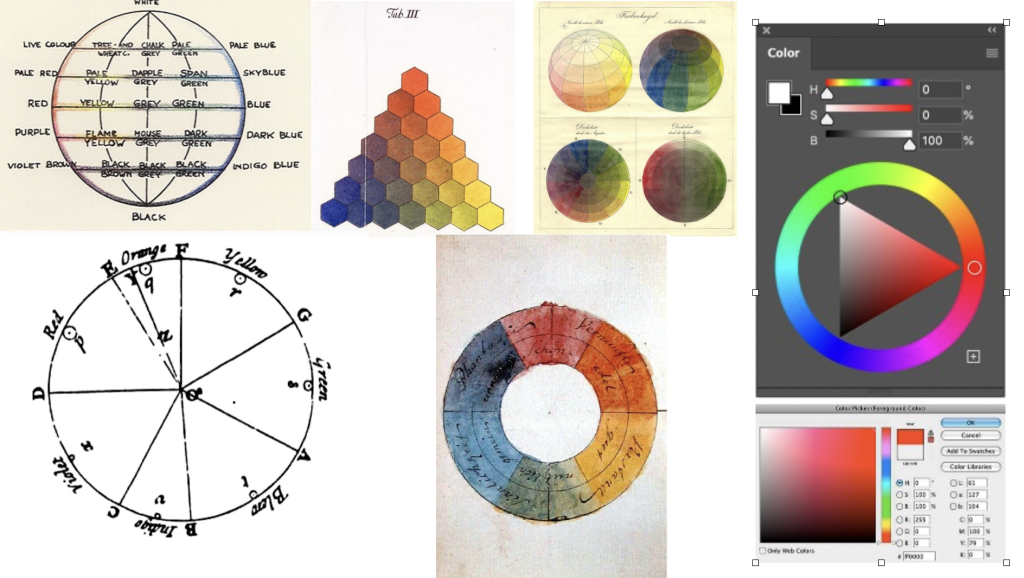Niveditha Ajay
The colour wheel is officially defined as an arrangement of colour generally in a circle that shows the relationship between primary and secondary colours, while also identifying complementary, contrasting and cancelling hues in the spectrum of colour. The popular illustration that plays a very important role in art and visual media today, developed over many centuries and is perhaps one of the best examples of both science and artistic expression developing together to facilitate invention and art. The colour wheel, with both traditional and digital interpretations, is made use of in fine arts such as painting as well as in technology- aiding both print and audio-visual media.
Humans have always been fascinated with colour, for its hue and vibrancy as well as what it teaches us about sight and the visual spectrum. In art, Colour Theory is an essential principle that involves learning the principles of colour, how they blend and form new colours as well as manipulating it appropriately to facilitate the artist’s vision. This extensive branch of study and active research within it is what helped later produce the earliest colour wheel. The earliest contributions to what later became colour theory can be found in the works of Aristotle, who defined two “principal colours” as being black and white, the absence and presence of light, and two “primary colours”- blue and yellow. Leon Battista Alberti and the artists of the Renaissance have been credited with laying the foundations of colour theory. Alberti noted the process of blending colours would produce different hues and that there were four “true colours” from which they could be derived- red of fire, the blue of air, the green of the water and the grey of earth.
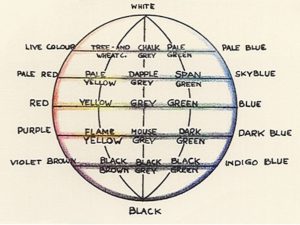
Courtesy: My Modern Met
The earliest form of the colour wheel was credited to Aron Sigfrid Forsius, who used the available knowledge to construct a wheel with five colours red, yellow, red, blue, and grey sandwiched between black and white. The scientific proof added by Isaac Newton through his experiment on the dispersion of light (from Opticks), that discovered white light to contain seven colours- violet, indigo, blue, green, yellow, orange and red, was a momentous addition to the study of colour and to create an illustrative medium of colour. As noted by Barnes, the crucial point added by Newton was the connection of the violet and red hues on either end of the spectrum- a fundamental feature of the colour wheel used today.
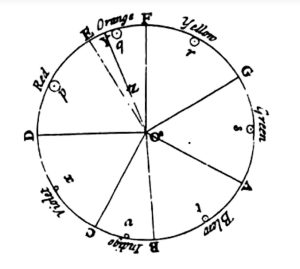
Courtesy: My Modern Met
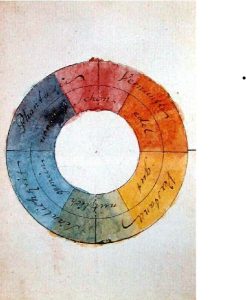
Courtesy: My Modern Met
While Newton’s theory of colour used light as the medium where colour exists and black as the absence of colour, Johann Wolfgang von Goethe begged to differ. Goethe noted that dark was a force of its own and that when hit with light, produced its own spectrum of colour. The contributions of Goethe and later Chevreul concluded the primary colours as red, yellow, and blue. It also added the concepts of additive mixing (light colours being mixed together) and subtractive mixing (coloured pigments being mixed together), still used in digital colour wheels today. Other significant models developed during the 18th and 19th centuries included Tobias Mayer’s colour triangle which provided the notion of gradations in hexagonal shapes lining the sides of a triangle, as well as Runge’s globe model that provided a three-dimensional take on the colour wheel- using a sphere instead, this model also involved cross-sectioning. In 1989, Albert Munsell created a cylindrical version- a cylinder graded from white to black with intersecting chroma. The cylinder had coloured rings of possible hues. The concept of displaying all possible combinations, that the model uses has once gained been retained in modern colour wheel software.
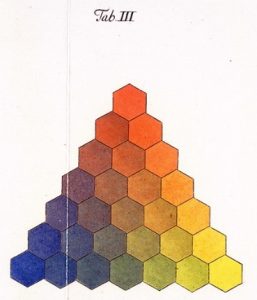
Source: My Modern Met
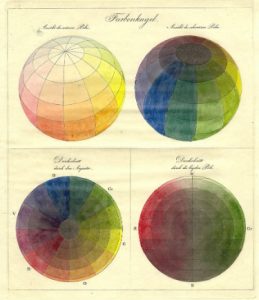
Courtesy: My Modern Met
John Caponigro analyses the Adobe colour wheel, one of the most prominently used digital colour wheels in the market today, keeping in mind the features all the above history has contributed to produce. Working on the advancements made to the Munsell model, the colour wheel shows hues in varying lightness and saturation, alongside a rainbow-coloured bar where sliding changes the hue altogether. Though not 3 dimensional, the model illustrates colours and all their gradations with refined precision. Caponigro also notes that 3D models, like that of Apple’s Colour Sync and Chromix’s Color, help show that colours though previously recorded as spheres are closer to teardrop shapes in 3D form. The first programme helps visualise the shape of different colour spaces and the latter helps in “plotting an image within the virtual volume”. The growth of 3D and 4D modelling and other developments in technology have contributed massively to the understanding of colour, its spectrum and structure.
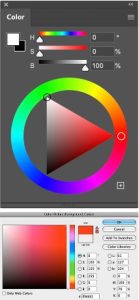
Courtesy: John Paul Caponigro
However, colour theory does not limit itself to simply understanding the structure of colour alone, it evokes recognition that colour goes beyond the visual medium alone- it elicits emotion, thought, cultural symbols and even music. The Russian artist Wassily Kandinsky was synthetic and interpreted colours as having a range of “feels” attached to them. According to his perception, yellow could be “warm and cheeky” to “disturbing for some”. Similarly, green can be peaceful and when excessive, boring. Blue could be peaceful too, as well as supernatural. Others included violet (morbid), black (extinguished), grey (balance between black and white), red (alive), orange (radiant) and many more.
The attached meaning and cultural symbols-based perception of colour have carried on significantly to film, advertising and much of the media we consume today. Villains dressed in black, comfort characters in yellow, childhoods having gold filters etc. are narrative techniques that utilise deeply embedded understandings of colours from a collective subconscious. In music too, colour-coded notations are often used to help young learners- there are eight colours in the rainbow as well as 8 octaves. Colour, thus, with its irreplaceable centrality in both the visual and perceptive structures of art is more than just a photoreceptor-based sensation. The evolution of the colour wheel and colour theory are testaments to the very human desire to add meaning and expand the limits of the vibrancy that surrounds us.
SOURCES
https://mymodernmet.com/color-wheel-history/
https://www.johnpaulcaponigro.com/blog/21881/brief-history-color-wheel/
https://www.artsy.net/article/the-art-genome-project-a-brief-history-of-color-in-art

